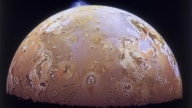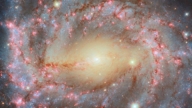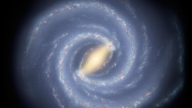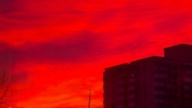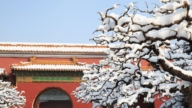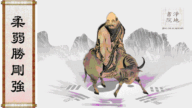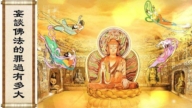【新唐人2011年5月19日讯】【看新闻学英语】
Rare Planetary Alignment Seen over Australia
澳洲出现罕见四星连线
By David Lee
【新闻关键字】
1. Planetary [ˋplænə͵tɛrɪ] adj. 行星的
2. celestial [sɪˋlɛstʃəl] adj. 天空的
3. Mercury [ˋmɝkjərɪ] n. 水星
4. Venus [ˋvinəs] n. 金星
5. Mars [mɑrz] n. 火星
6. Jupiter [ˋdʒupətɚ] n. 木星
7. align [əˋlaɪn] v. 排成直线
8. pre-dawn黎明前
9. spectacle [ˋspɛktək!] 景象; 奇观, 壮观
10. occur [əˋkɝ] v. 发生
A rare celestial event was seen over Sydney, Australia on Thursday and Friday.
周四及周五在澳洲雪梨目睹到一椿稀有的天文事件。
Mercury, Venus, Mars and Jupiter were aligned together in a pre-dawn spectacle that only occurs every 50 to 100 years.
水星、金星、火星与木星在黎明前排成一列,这样的壮观景象,只有每50年至100年才会发生一次。
11. Astronomy [əsˋtrɑnəmɪ] n. 天文学
12. observatory [əbˋzɝvə͵torɪ] 天文台、瞭望台
13. binocular [bɪˋnɑkjəlɚ] n. 双筒望远镜
14. recommend [͵rɛkəˋmɛnd] v. 推荐
15. triangle [ˋtraɪ͵æŋgl] n. 三角形
16. hemisphere [ˋhɛməs͵fɪr] n. 半球
17. horizon [həˋraɪzn] n. 地平线
[Geoff Wyatt, Sydney Observatory Senior Astronomy Educator]:
“It is unusual. The last time we had these four planets together was in 1910, but they were too close to the sun to be seen with any detail.”
雪梨天文台资深天文教育员Geoff Wyatt说:“这是很不寻常的。上一次四星连线是在1910年,但因过于接近太阳,以致于无法看到任何细节。”
Sky-watchers gathered on Friday outside the Sydney Observatory to witness the four planets coming together within a few degrees of each other.
天空观察家们周五聚集在雪梨天文台外边,目睹四星从小角度到连线在一起的过程。
While it can be seen with the naked eye, a telescope or binoculars are recommended.
同时这过程可以用肉眼就能看到,当然建议用望远镜或是双筒望远镜。
Venus, Jupiter and Mercury formed a small triangle, with Mars slightly harder to see.
由于火星有点难看到,此时金星、木星和水星形成一个小三角形。
The astronomical event will continue throughout the month of May, with the planets changing their positions from day to day, forming various interesting patterns in a planetary dance.
这项天文奇观将持续整个五月,随着行星们每天都会改变位置,就像是行星跳舞一般,会形成各种不同的有趣的形态。
Viewers in the northern hemisphere need a clear view to the east horizon to see it in the pre-dawn sky.
在北半球的观察者要有清楚的景象,可在黎明前朝向东边水平线的天空望去。
The best views will be in the southern hemisphere where the planets are positioned much higher in the sky.
最好的景象将会是在南半球,在天空中的行星位置就会高的多。
本则影音新闻出处:新唐人电视台英语新闻
http://english.ntdtv.com/ntdtv_en/ns_life/2011-05-13/rare-planetary-alignment-seen-over-australia.html
本专栏由前卫英语李德良老师主编 www.davidlee.url.tw
【佳句精选】
Mercury, Venus, Mars and Jupiter were aligned together in a pre-dawn spectacle that only occurs every 50 to 100 years.
水星、金星、火星与木星在黎明前排成一列,这样的壮观景象,只有每50年至100年才会发生一次。
【每日一句】
It is unusual. 这是很不寻常的
【英文说文解字】
各位读者好:
日前,新竹 园区公会邀请David老师,讲授《如何高效学看英语新闻》,现场有六十多位公会成员聆听,台积电就来了十多位。
李老师首先指出,台积电董事长张忠谋先生在台大EMBA毕业典礼时,就曾强调看英语新闻的重要性。香港及亚洲首富李嘉诚,也是靠看外文杂志,察觉到塑胶花的时机性,因而赚到人生的第1个100万;同时每天早上5:59一定起床,为的就是听英语新闻。
但是台湾很多人却无法阅读英语新闻,多数当然觉得是英文字汇不够;但David老师却反向思考:其实是因为国人没有习惯看英语新闻,所以英文字汇不够!老师提出一套“吸英大法”,意思就是从英文媒体中大量吸收英文字汇的方法。但这就得有“基本功”,不然的话看英语新闻,就只有挫折感,遑论吸收了!
那么到底要如何“高效学看英语新闻”呢?David老师是运用了独创的BOS(Brain Operating System)英语学习法,剖析出英语新闻的深层结构,比如一旦掌握了灾难新闻的深层结构,看灾难新闻就变得很容易;那么再进一步掌握社会新闻、政治新闻、财经新闻、科技新闻…的深层结构,这样由点、到线、到面,就能够很轻松地征服懂英语新闻。
企业需要管理,字汇也需要管理;而David老师的BOS系统英语学习法,就是用KM(Knowledge Management, 知识管理)处理VM(Vocabulary Management, 字汇管理)。
举个具体例子,新闻就是报导昨天“发生”了什么事,但李老师指出“发生”有三种,一般的发生英文记者会使用happen, occur, take place,强烈的发生则会用erupt, break out,还有一种是“慢慢的发生”,叫做浮现,记者会使用emerge, loom。如果这样结构性的掌握的话,那么不论是发生哪一类新闻,不论英文记者怎么用字,就都看的懂了!
比如今天这则天文新闻中,Mercury, Venus, Mars and Jupiter were aligned together in a pre-dawn spectacle that only occurs every 50 to 100 years. 每50年到100年才会“发生”,英文记者就是用了“occur”这个字。
天文学为什么是astronomy呢?因为aster是star星星的意思,所以astrology是占星学,astronomy则是天文学。Disaster为什么是灾难呢?dis-是否定字首,因为星象不对了,人间就出现灾难了。古代天文家观星相,就知道人间将有大事发生了!
Meteor是流星,meteorology是气象学,从造字上看,西洋古人认为,流星的出现与变化是与人间的气象变化有相关的。
2010年出现罕见的日全蚀(total solar eclipse),就有专家指出,依据古代的记载,当日全蚀出现时,常会伴随着人间的大型灾难(catastrophe)。这两年世界各地确实都出现了罕见的大灾难。
日全蚀的出现,也是一种“三星一线”─ 太阳、月球、地球,三行星(planet)连成一线。九大行星当中,通常会有两颗到三颗的行星,每几年之后就会走近,但金星(Venus)、木星(Jupiter)、水星(Mercury)、火星(Mars)四颗行星要同时走在一条线上(alignment),非常罕见。另外几颗行星的英文是:土星(Saturn)、天王星(Uranus)、海王星(Neptune)、冥王星(Pluto)。
且让我们拭目以待,这一次的四星连线后,人间会有什么变化?!




